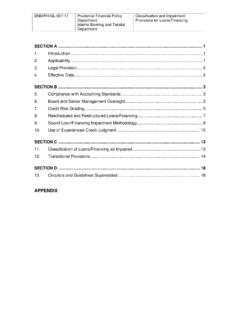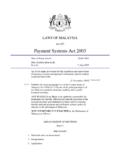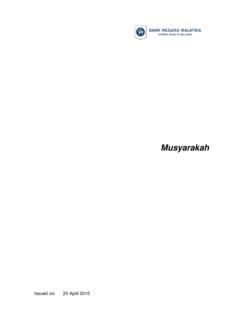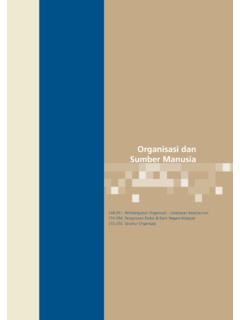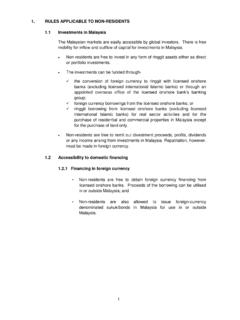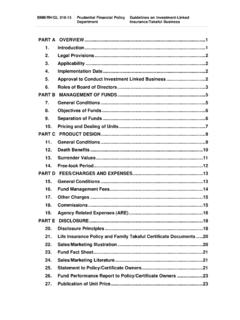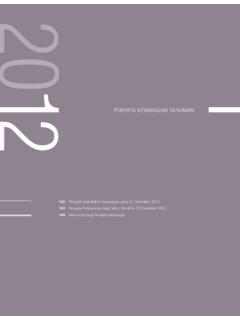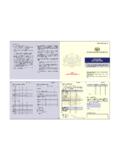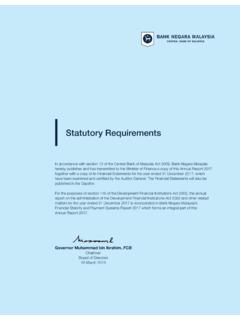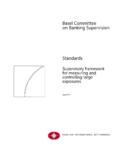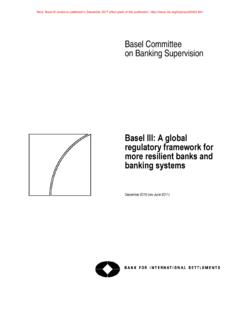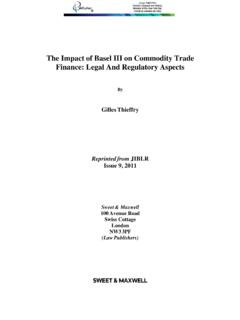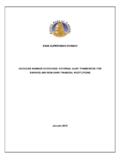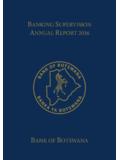Transcription of 1. Overview2 2. Approach to implementing …
1 BNM/RH/NT 007-25 Prudential Financial Policy Department Islamic banking and Takaful Department Implementation of basel III 1. 2. Approach to implementing individual elements of the reform 3. Reporting requirements and supervisory expectations during the Appendix 1 Phase-in BNM/RH/NT 007-25 Prudential Financial Policy Department Islamic banking and Takaful Department Implementation of basel III Page 2/11 1. Overview In December 2010, the basel Committee on banking Supervision ( basel Committee ) finalised a package of measures to strengthen global capital and liquidity rules with the goal of strengthening the resilience of the global banking system.
2 The rules are detailed out in the documents basel III: A global regulatory framework for more resilient banks and banking systems and basel III: International framework for liquidity risk measurement, standards and monitoring1 (collectively referred to as basel III). Bank Negara Malaysia ( the Bank ) supports the implementation of these reform measures and will strengthen the existing capital and liquidity standards for banking institutions in Malaysia2, bringing them in line with basel III.
3 The Bank targets to implement the reform package in Malaysia in accordance to the globally-agreed levels and implementation timeline which provides for a gradual phase-in of the standards beginning 2013 until 2019 (refer to Appendix 1). This paper sets out the Bank s Approach to incorporating the individual elements of the reform package into the domestic regulatory and supervisory framework, as well as its expectations of banking institutions with respect to managing the transition towards the new regime.
4 1 From time to time, the basel Committee publishes additional documents detailing out individual components of the basel III reform package. These and other related documents are available at its website ( ). For the purpose of implementation in Malaysia, the basel III reform package is defined to also include enhancements to the basel II framework made by the basel Committee in July 2009, as well as other remaining components of the basel II framework which have yet to be implemented in Malaysia.
5 2 Namely the Risk-Weighted Capital Adequacy Framework and Capital Adequacy Framework for Islamic Banks, and the Liquidity Framework. BNM/RH/NT 007-25 Prudential Financial Policy Department Islamic banking and Takaful Department Implementation of basel III Page 3/11 2. Approach to implementing individual elements of the reform package Enhancing the definition of capital The Bank supports the aim of basel III to strengthen the quality of capital held by banking institutions and intends to implement the new definition of regulatory capital which provides greater focus on common equity, while also strengthening the eligibility criteria for other capital instruments.
6 A concept paper detailing out the revised definition of regulatory capital (including the eligibility criteria for new capital instruments) will be issued for industry consultation in the first quarter of 2012, with the revised rules expected to be finalised by mid-2012 and implemented beginning January 2013 in accordance with the timelines set under basel III (refer to Appendix 1). All non- basel III compliant capital instruments issued prior to the issuance of this circular will continue to be recognised post-2013, subject to a gradual phasing-out by 2023.
7 Any new issuances of capital instruments by banking institutions in 2012 will only be considered by the Bank for approval if such capital instruments comply with the eligibility criteria set forth by the basel Committee3. These instruments will continue to be recognised under basel III ( post-2013) even if the revised capital definition to be issued by the Bank is more stringent than the criteria set by the basel Committee. The concept paper will provide greater detail on the Approach to phasing-out non-compliant capital instruments and the phasing-in of the regulatory requirements, including that relating to the basel II deduction rules which have yet to be implemented in Malaysia and the regulatory adjustments under basel III.
8 3 Issuances of new capital instruments which do not contain clauses intended to ensure loss absorbency at the point of non-viability but meet all other basel III criteria will also be considered, but may be gradually phased-out beginning 2013. BNM/RH/NT 007-25 Prudential Financial Policy Department Islamic banking and Takaful Department Implementation of basel III Page 4/11 Raising the minimum capital requirements and introducing capital buffers In addition to strengthening the quality of capital, minimum capital requirements for banking institutions in Malaysia will be raised in line with the levels determined under basel III.
9 banking institutions will also be required to hold a capital conservation buffer comprising common equity of over-and-above the regulatory minimum4. Table 1 illustrates the new capital requirements, including buffers, against the basel II standard underpinning the present Risk-Weighted Capital Adequacy Framework and Capital Adequacy Framework for Islamic Banks. Table 1 Common Equity Tier 1 Capital Ratio Core Capital Ratio (CCR)5 Risk-Weighted Capital Ratio (RWCR)6 basel III Minimum 6% 8% Conservation buffer + Minimum plus conservation buffer 7% basel II Minimum 2% 4% 8% As part of the Bank s efforts to strengthen its macroprudential toolkit to deal with systemic risk, the Bank will also consider introducing a countercyclical capital buffer regime in line with basel III which will require banking institutions to hold variable amounts of capital buffers over-and-above the capital conservation buffer7.
10 The operation and magnitude of the countercyclical 4 banking institutions will generally be able to conduct business as normal when their capital levels fall into the conservation range as they experience losses, although they will be subject to restrictions on their distributions ( payment of dividends). On the other hand, banking institutions will be subject to the strongest supervisory sanctions when breaching minimum regulatory levels. 5 Also referred to as the Tier 1 Capital Ratio.
